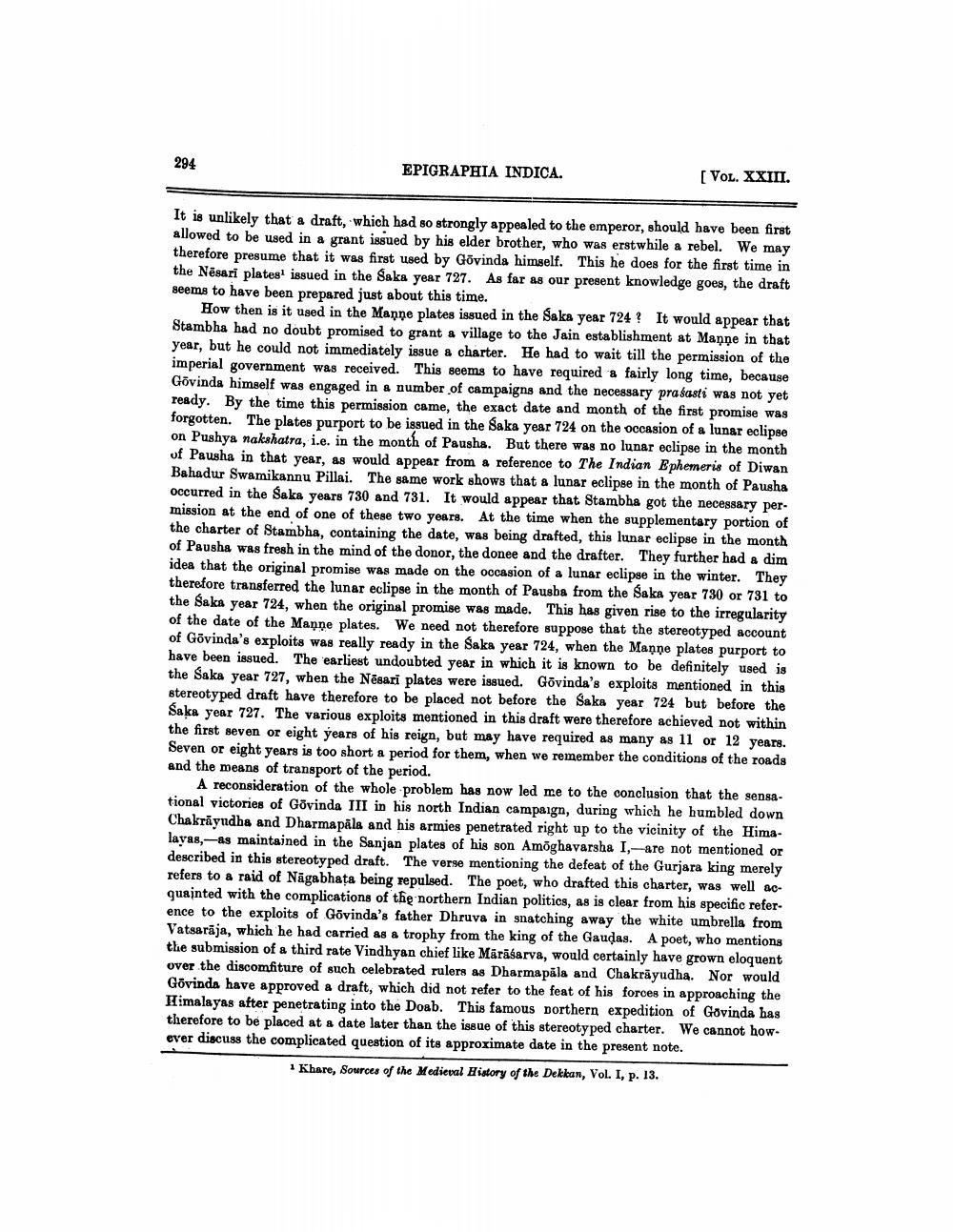________________
294
EPIGRAPHIA INDICA.
[VOL. XXIII.
It is unlikely that a draft, which had so strongly appealed to the emperor, should have been first allowed to be used in a grant issued by his elder brother, who was erstwhile a rebel. We may therefore presume that it was first used by Govinda himself. This he does for the first time in the Nesari plates1 issued in the Saka year 727. As far as our present knowledge goes, the draft seems to have been prepared just about this time.
How then is it used in the Manne plates issued in the Saka year 724? It would appear that Stambha had no doubt promised to grant a village to the Jain establishment at Manne in that year, but he could not immediately issue a charter. He had to wait till the permission of the imperial government was received. This seems to have required a fairly long time, because Govinda himself was engaged in a number of campaigns and the necessary prasasti was not yet ready. By the time this permission came, the exact date and month of the first promise was forgotten. The plates purport to be issued in the Saka year 724 on the occasion of a lunar eclipse on Pushya nakshatra, i.e. in the month of Pausha. But there was no lunar eclipse in the month of Pausha in that year, as would appear from a reference to The Indian Ephemeris of Diwan Bahadur Swamikannu Pillai. The same work shows that a lunar eclipse in the month of Pausha occurred in the Saka years 730 and 731. It would appear that. Stambha got the necessary permission at the end of one of these two years. At the time when the supplementary portion of the charter of Stambha, containing the date, was being drafted, this lunar eclipse in the month of Pausha was fresh in the mind of the donor, the donee and the drafter. They further had a dim idea that the original promise was made on the occasion of a lunar eclipse in the winter. They therefore transferred the lunar eclipse in the month of Pausha from the Saka year 730 or 731 to the Saka year 724, when the original promise was made. This has given rise to the irregularity of the date of the Manne plates. We need not therefore suppose that the stereotyped account of Govinda's exploits was really ready in the Saka year 724, when the Manne plates purport to have been issued. The earliest undoubted year in which it is known to be definitely used is the Saka year 727, when the Nesari plates were issued. Govinda's exploits mentioned in this stereotyped draft have therefore to be placed not before the Saka year 724 but before the Saka year 727. The various exploits mentioned in this draft were therefore achieved not within the first seven or eight years of his reign, but may have required as many as 11 or 12 years. Seven or eight years is too short a period for them, when we remember the conditions of the roads and the means of transport of the period.
A reconsideration of the whole problem has now led me to the conclusion that the sensational victories of Govinda III in his north Indian campaign, during which he humbled down Chakrayudha and Dharmapala and his armies penetrated right up to the vicinity of the Himalayas, as maintained in the Sanjan plates of his son Amoghavarsha I,-are not mentioned or described in this stereotyped draft. The verse mentioning the defeat of the Gurjara king merely refers to a raid of Nagabhata being repulsed. The poet, who drafted this charter, was well acquainted with the complications of the northern Indian politics, as is clear from his specific reference to the exploits of Govinda's father Dhruva in snatching away the white umbrella from Vatsaraja, which he had carried as a trophy from the king of the Gaudas. A poet, who mentions the submission of a third rate Vindhyan chief like Märäsarva, would certainly have grown eloquent over the discomfiture of such celebrated rulers as Dharmapala and Chakrayudha. Nor would Govinda have approved a draft, which did not refer to the feat of his forces in approaching the Himalayas after penetrating into the Doab. This famous northern expedition of Govinda has therefore to be placed at a date later than the issue of this stereotyped charter. We cannot however discuss the complicated question of its approximate date in the present note.
1 Khare, Sources of the Medieval History of the Dekkan, Vol. I, p. 13.




